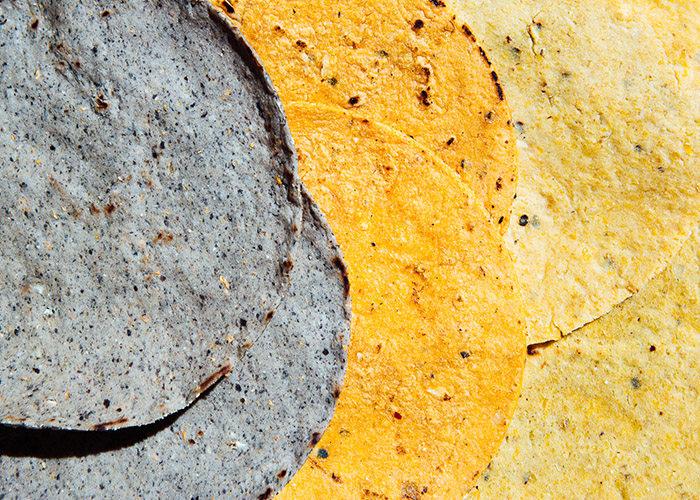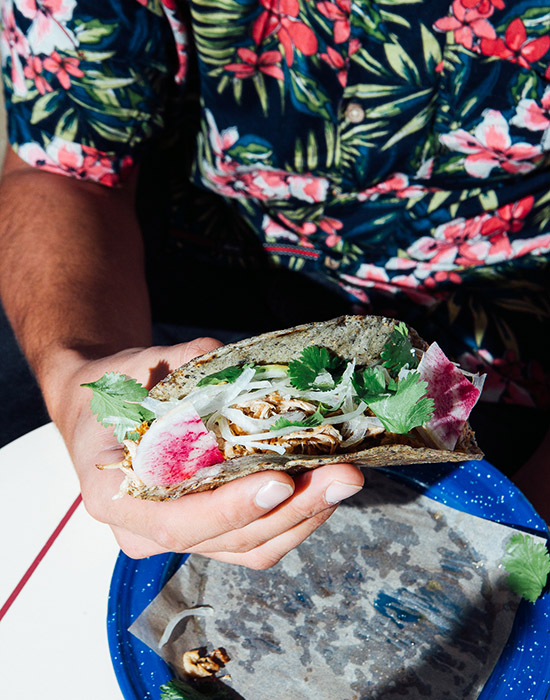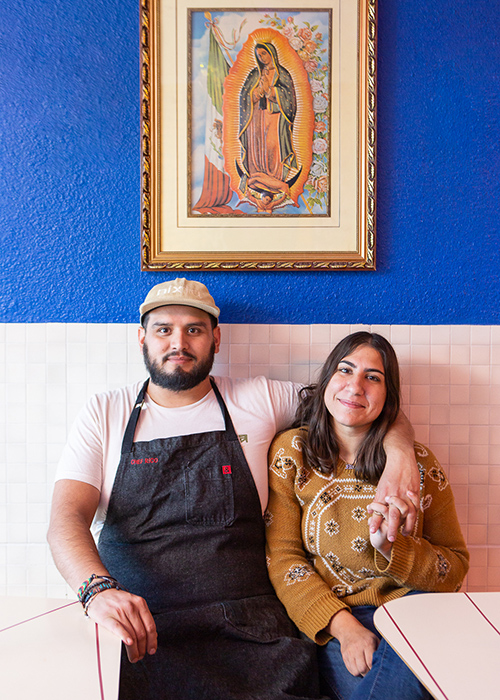Try Nixta Taqueria’s Colorful Corn Tortillas Made with an Ancient Mayan Technique
Chefs at the East Austin eatery use a 12-hour nixtamalization process to make tortillas

On the corner of East 12th and Cedar Avenue, Austinites can now find a bright purple and blue building adorned with a Mesoamerican mural. Everything inside, from the lotería cards, the floor-to-ceiling murals of corn, to the hip-hop and Selena blasting on the speakers pays a playful, modern homage to Mexican culture.
Nixta Taqueria, a new restaurant owned by Chef Edgar Rico and General Manager Sara Mardanbigi, derives its name from an ancient Mayan technique for preparing corn: nixtamalization. This chemical process transforms corn kernels into a dough called masa.

Chef Rico and his team prepare fresh tortillas every night. They source their blue corn from Oaxaca, Mexico, and red, white and green corn from Barton Springs Mill in Dripping Springs. The kernels soak in lye, a sodium hydroxide solution, overnight.
“By letting the corn cook overnight in this solution, it extracts the natural gelatin and starches that are in the corn,” explains Rico. “It essentially acts as a binder for the tortilla.”

After the overnight soak the team rinses the corn – now almost doubled in size – twice. At this point the corn is what Chef Rico calls “medium rare” because it’s cooked on the outside but still raw in the middle. Then the corn goes through Nixta’s molino, a corn grinder that uses two volcanic stones. The ridges in the stones cause the corn to expand outwards and become fine in texture, creating a light masa dough. Chef Rico adjusts the moisture level and seasoning before meticulously shaping each tortilla by hand and cooking it on the plancha, a flat-top iron stove.
The process takes about 12 hours from kernel to plate.

“Our food is foundationally Mexican,” says co-owner Sara Mardanbigi. “But the hardest thing that we’ve come up against is this question of authenticity and what a taco is. There’s a lot of people with opinions about it.”
Questions of authenticity, while not completely invalid, aren’t necessarily relevant without taking into account Rico and Mardanbigi’s backgrounds and motivations. Rico is from the Central Valley in California, where he developed a love for produce and using local ingredients. He graduated from the Culinary Institute of America and has cooked professionally for 12 years. Rico staged at Pujol in Mexico City under Enrique Olvera, a world-renowned chef known for his elevation of Mexican cuisine and his 1000 day mole.

Mardanbigi is Persian and entered the restaurant industry when she became the Senior Events Coordinator at Peached Social House. She met Rico there right before becoming Torchy’s Tacos’ Talent Engagement Manager. As first-generation Americans, Rico and Mardanbigi strive to “take what they ate growing up and transform it into the next thing: the 2.0 version.”
Diners at Nixta won’t find many widespread Tex-Mex staples. There are no baskets of chips and salsa or fajitas sizzling on cast-iron skillets. What diners can expect are complex flavors and textures thoughtfully incorporated into dishes that would make the owners’ parents and family proud.

To Rico, one of the most authentic dishes on Nixta’s menu is the Enchilada Potosina. The dish is regionally specific to San Luis Potosí in Mexico, where Rico’s family is from.
“What makes it different is that we fold salsa right into the masa,” says Rico. “So it makes this bright red tortilla. Then we put chorizo potato puree on it, duck fat refried beans, cabbage and queso enchilado sourced straight from Mexico.”

Inspired by his time at Pujol, Rico aims to “educate people on why should be in the hierarchy of great gastronomical cuisines.” He specifically chose tacos as the main menu item because they provide an easy gateway for new diners as well as a blank canvas for Rico and Mardanbigi’s culinary creativity and experimentation.
Mardanbigi especially looks forward to playing with Middle Eastern flavors and ingredients like rosewater, pistachios and pomegranates. For a previous daily special she collaborated with Rico to create a braised lamb neck taco with creamy sumac, pickled fennel, lacto-fermented hot sauce and herbs served on a Oaxacan blue corn tortilla.

“We’re just two young people trying to create something together, trying to make our parents proud and seeing what we can accomplish together,” says Mardanbigi.
Nixta is open every day except Monday (though you can still find Rico inside the restaurant, cleaning the molino’s volcanic stones and preparing duck). If you have a hard time deciding what to order, the owners’ current favorite dish on the menu is the beet tartare tostada.The World in a Pocket is dedicated to exploring the world through the lens of a dumpling. From mandu to empanadas, spanakopita to gyoza, pierogi to Pop-Tarts, this is our love letter to pockets worldwide and the stories they tell. These beloved staples all share a similar food-inside-of-food structure, while providing a delicious way to understand our world. We are excited to bring TRIBEZA readers Austin in a Pocket, where Regine Malibiran has teamed up with TWIP co-founder and photographer Mackenzie Smith Kelley to shine a light on local pocket makers.
